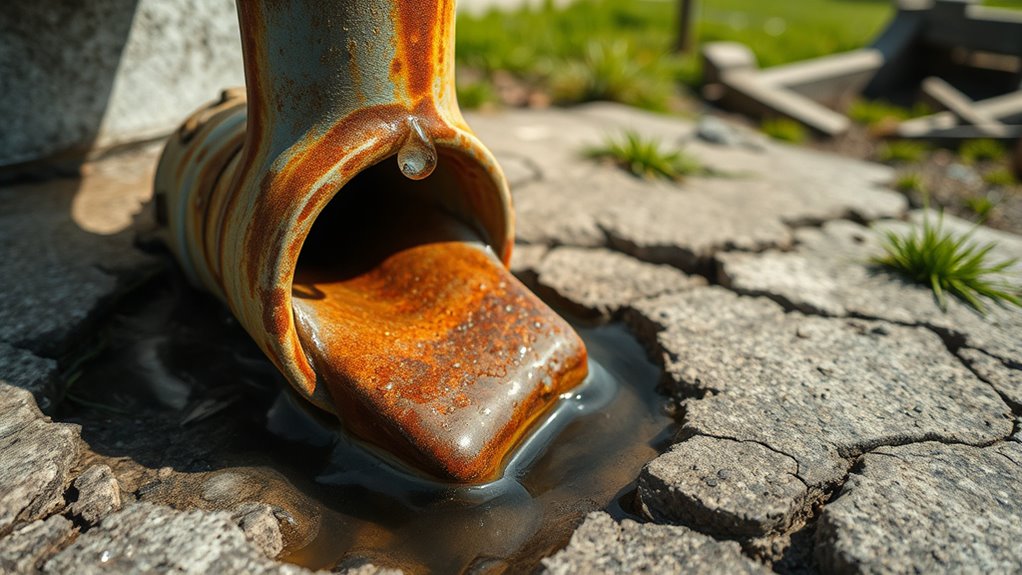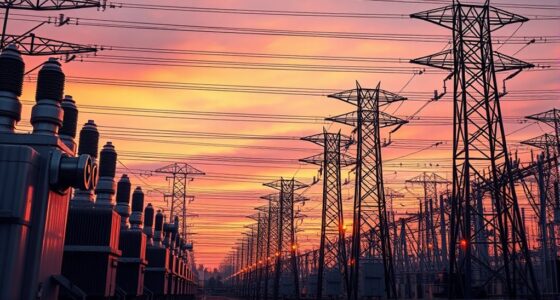America’s aging water infrastructure hides significant costs, including hidden damage in corroded pipes that cause dangerous lead contamination and leaks. This deterioration increases health risks, especially for vulnerable groups, while raising repair and energy expenses for communities. Deferred maintenance and outdated materials exacerbate the problem, leading to costly emergency fixes. Investing in modern technology and proactive upkeep can prevent these hidden expenses from spiraling. To see how these issues impact your community, keep exploring the challenges ahead.
Key Takeaways
- Aging pipelines increase risks of leaks, bursts, and contamination, often hidden beneath streets, leading to costly repairs and health hazards.
- Lead leaching from corroded pipes poses silent health threats, especially to children and vulnerable populations.
- Deteriorating infrastructure raises energy and maintenance costs, diverting funds from community development and safety efforts.
- Lack of proactive maintenance and outdated technology hinder early detection of corrosion and water quality issues.
- Investing in corrosion-resistant materials and advanced testing can prevent costly failures and protect public health long-term.

America’s water infrastructure is aging, and the true costs of neglecting it go far beyond what’s immediately visible. As pipelines grow old and corrode, the risk of lead contamination rises sharply. You might not see the damage on the surface, but beneath the streets, deteriorating pipes threaten to release harmful substances into your drinking water. Lead, once common in plumbing materials, leaches into water supplies as pipelines corrode over time, especially when maintenance is deferred. This contamination poses serious health risks, particularly for children, pregnant women, and vulnerable populations. Chronic exposure to lead can cause developmental issues, cognitive impairments, and a host of other health problems, often without you even realizing it’s happening. The true danger lies in how insidious this contamination can be—silent, persistent, and difficult to detect without proper testing.
Pipeline corrosion is a silent enemy that accelerates as infrastructure ages. Steel and iron pipes, which make up a significant portion of the existing network, are prone to rust and decay. Over decades, corrosion eats away at the pipe walls, creating tiny holes and weak points. These weak spots not only increase the likelihood of leaks and pipe bursts but also allow contaminants like lead and other pollutants to seep into your water. When corrosion isn’t addressed promptly, it becomes more costly to repair and more dangerous to your health. You might notice discolored water or a metallic taste, but often, the damage is hidden deep within the piping system. The longer corrosion goes unchecked, the greater the risk of a major failure that disrupts water supply and demands expensive emergency repairs.
Neglecting these issues also has economic implications you shouldn’t ignore. As infrastructure deteriorates, water systems require more energy to operate, increasing costs for utilities and, ultimately, for consumers. Frequent repairs and replacements add up, diverting funds from other critical community needs. Additionally, the burden of health issues caused by lead exposure can lead to increased healthcare costs, lost productivity, and long-term societal impacts. Addressing pipeline corrosion and lead contamination now can save you money in the long run, but it demands proactive investments and policy changes. Without action, you risk facing not only the health hazards associated with contaminated water but also the escalating costs of emergency repairs and health consequences that ripple through your community.
Furthermore, adopting innovative solutions like corrosion-resistant materials and implementing comprehensive maintenance programs are essential steps toward safeguarding water quality for future generations. Regularly updating infrastructure with state-of-the-art technology can help detect issues early and prevent severe damage. Recognizing the importance of preventative maintenance can significantly extend the lifespan of existing infrastructure and reduce long-term costs.
By investing in advanced testing methods, communities can better identify hidden corrosion and contamination issues before they become critical problems, ultimately protecting public health and reducing long-term expenses.
Frequently Asked Questions
How Does Aging Infrastructure Impact Water Quality and Public Health?
Aging infrastructure can seriously impact your water quality and public health by increasing lead contamination and pathogen risks. Old pipes may leach lead into your drinking water, posing health hazards, especially to children. Additionally, deteriorating systems can allow harmful pathogens to enter the water supply, increasing the chance of waterborne illnesses. Upgrading infrastructure is essential to safeguard your health, guarantee clean water, and prevent costly health issues down the line.
What Funding Sources Are Available for Infrastructure Upgrades?
Think of funding sources as crucial lifelines for your water systems. You can tap into public-private partnerships, where private companies invest in infrastructure upgrades, or secure federal grants designed to fuel essential repairs. These resources act as bridges, connecting communities to the funds needed for safer, cleaner water. By leveraging these options, you can help guarantee your water infrastructure stays resilient and reliable for generations to come.
Are There Technological Innovations to Modernize Old Water Systems?
You can modernize old water systems by adopting innovative technologies like smart sensors and leak detection systems. These tools allow you to monitor water flow in real-time, quickly identify leaks, and prevent waste. Implementing such innovations not only improves efficiency but also reduces costs associated with repairs and water loss. By integrating these smart solutions, you guarantee your water infrastructure stays reliable and sustainable for the future.
How Do Local Governments Prioritize Infrastructure Repair Projects?
You might think local governments have unlimited resources, but they’re actually juggling a tiny budget for infrastructure repair. They prioritize projects based on political influence and urgency, often ignoring long-term needs. Sometimes, they throw money at visible, high-profile issues instead of fixing aging pipes underground. It’s a constant balancing act where politics and limited funds determine which repairs happen first, leaving critical infrastructure vulnerable to failure.
What Are the Long-Term Economic Benefits of Investing in Water Infrastructure?
Investing in water infrastructure offers significant long-term economic benefits. You’ll see a positive cost benefit analysis as improved systems reduce repair costs and prevent costly failures. This investment boosts economic resilience by providing reliable water services, attracting businesses, and supporting community health. Over time, these benefits outweigh initial expenses, creating a more sustainable and prosperous environment for you and your community, ensuring water security for future generations.
Conclusion
As you consider America’s aging water systems, remember that over 240,000 water main breaks occur annually, costing cities billions and risking public health. These hidden costs grow as infrastructure ages, often leading to costly repairs and service disruptions. By investing now, you can help protect communities from future crises and save money in the long run. Clearly, addressing these hidden costs isn’t just necessary—it’s essential for a safer, more reliable water future.
Amina brings over a decade of journalism experience to her role as Editor-in-Chief. Under her leadership, Exquisite Post has flourished, maintaining the highest standards of integrity and excellence. Amina’s commitment to truth and her visionary approach guide the editorial team in producing impactful news stories that resonate with our audience.










